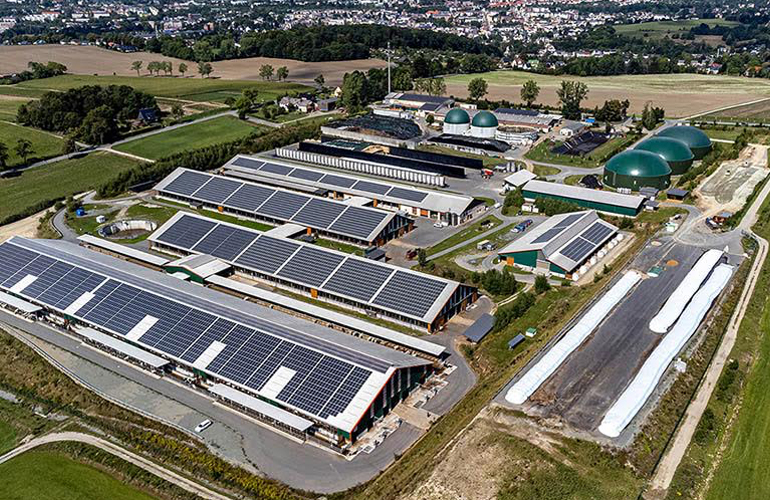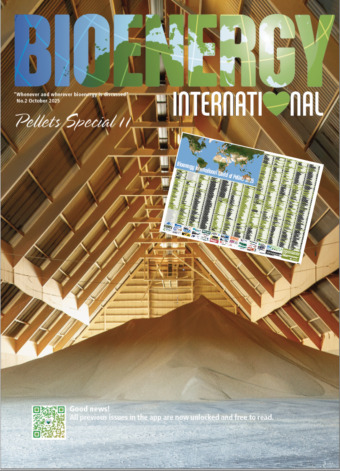In March 2024, German dairy farm and biogas company Agrar GmbH Reichenbach commissioned a Kumac digestate processing system from compatriot biogas plant technology provider Weltec Biopower GmbH. Although there are 16 Kumac digestate processing plants installed worldwide, this is the first Kumac plant to go live in Germany.
In addition to the dairy farm with 1,400 cows and breeding cattle, the farm has operated a biogas power plant with an electrical output of 845 kWe since 2006.
The biogas plant’s main business is the supply of raw biogas via a 3.2-km pipeline to the heating plant of municipal energy company Stadtwerke Reichenbach for the base load heat supply to flats and social facilities.
The onsite genset feeds electricity into the public grid daily and supplies up to 500 kW of heat to small consumers and the site of the former Paracelsus Clinic in Reichenbach via a heating network.
Tried-and-tested processes
The facility generates up to 72,000 tonnes of liquid manure and digestate annually.
Within the scope of the Leipzig Biogas Expert Talks, the German Bioenergy Association – Deutsche Biomasseforschungszentrum gemeinnützige GmbH (DBFZ) had already invited visitors to the Application Day in Reichenbach in December 2023.
Numerous professional visitors took the opportunity to visit the biogas plant as the Kumac digestate processing plant. Modern technologies and systems, such as the Kumac system, greatly contribute to the recycling of nutrients and conversion of liquid manure into compost, biofertilizer, animal bedding, or biogas substrate.
For the conversion, Kumac uses tried-and-tested processes that are fine-tuned to each other.
High-quality biofertilizer for arable farming
In Reichenbach, the output of the Kumac process consists of around 25 percent solid and 20 percent liquid farm manure and 55 percent dischargeable water. The resulting solid matter and the nutrient concentrate are applied as organic, high-quality fertilizers to our crops. In this way, long transport routes are avoided. This closes an efficient material flow cycle, and the individual areas of our portfolio interlock perfectly. From the cultivation of feed crops to dairy farming to the utilization of the liquid manure in the biogas plant and the processing of digestate into fertilizer and water, all components have their place explained Lars Bittermann, Managing Director of Agrar GmbH Reichenbach.
30 percent dry matter content
In the first treatment step, flocculants are added to the source material – liquid manure and digestate.

These additives ensure the flocculation of even the finest components, facilitating their separation from the water. At the same time, they contribute to the reduction of odour emissions.
After the material has been squeezed through a belt press the solid material can be used directly as fertilizer, compost, animal bedding, or biogas substrate with a dry matter content of up to 30 percent.
Subsequently, the liquid phase passes a tank where small particles and suspended solids are separated. Any remaining solid particles are removed through a fine filter.
In the next step, the filtrate traverses a three-stage reverse osmosis process to remove salts and nutrients. The resulting liquid fertilizer is nitrogen-rich and only 25 percent of the original volume.
Clearwater accounts for the greatest share of the treatment products and is currently discharged into the receiving water.
The processing here is almost fully automated, which also minimizes the amount of personnel required, said Lars Bittermann.
Support from the European Agricultural Fund
The scalable modular system starts at around 70,000 tonnes of liquid manure or digestate per annum.
Should the processing needs increase, several Kumac lines can be combined.
Operators who decide to set up a system may be eligible to receive funding from the European Agricultural Fund for Rural Development, added Nico Sudbrink, the responsible process engineer at Weltec Biopower.



